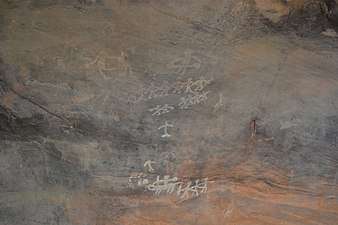Jhumair
Jhumair or Jhumar is an Indian folk dance from the Indian states of Bihar, Jharkhand, Chhattisgarh, Odisha and West Bengal.[1][2] It is folk dance of Sadan.[3][4][5] It is quite famous among Tea-garden community of Assam.[6]

History

Jhumair is an ancient folk dance. Similar dance found in Mesolithic paintings of Bhimbetka rock shelters.
Performance
Jhumair is a community dance performed during the harvest season and festivals. [7] The dance is mostly performed in open places. Traditional Musical instruments generally used are Dhol, Mandar, Bansi, Nagara, Dhak and Shehnai etc.
Lyrics
The lyrics of Jhumair are built on day-to-day languages and mostly depict love or pleasures and pains of day-to-day life.
Varieties
There are variety of Jhumair in the region of Chota Nagpur Plateau such as:
- Kurmali Jhumair
- Panchpargania Jhumair
The Jhumair/Jhumar from different region vary from each other in style.[8] [9]
See also
- Mardana Jhumair
References
- "Jhumari Dance". dance.anantagroup.
- "Jhumar and other popular folk dances of Jharkhand". mythicalindia.
- "Encyclopædia Mundarica, Volume 2". books.google.com.
- "Out of the Dark". democratic world.in.
- "talk on nagpuri folk music at ignca". daily Pioneer.
- "Karam Puja". assaminfo.
- http://www.dance.anantagroup.com/jhumari-dance/
- Stephen Blum; Philip Vilas Bohlman; Daniel M. Neuman (1993). Ethnomusicology and Modern Music History. University of Illinois Press. pp. 224–. ISBN 978-0-252-06343-5.
- "Out of the Dark". democratic world.in.